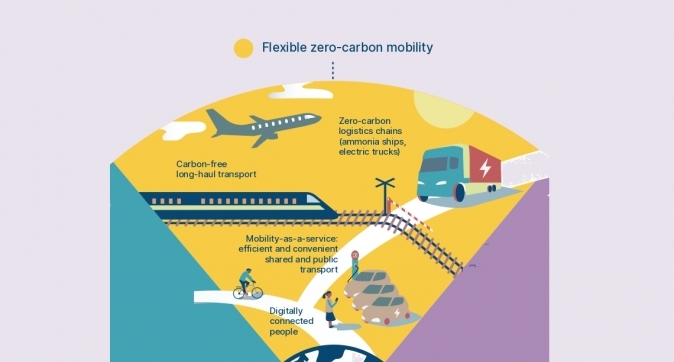ETC envisions net-zero-carbon world; focus on transport, shipping, aviation
October 7, 2020: Energy Transitions Commission (ETC), a coalition of 40 global energy producers, energy-intensive industries, financial institutions and environmental advocates including Tata Group, Volvo and Heathrow Airport, has launched a new report in September 2020 highlighting actions required by 2030 to achieve zero-carbon economy by mid-cen

October 7, 2020: Energy Transitions Commission (ETC), a coalition of 40 global energy producers, energy-intensive industries, financial institutions and environmental advocates including Tata Group, Volvo and Heathrow Airport, has launched a new report in September 2020 highlighting actions required by 2030 to achieve zero-carbon economy by mid-century.
The report titled ‘Making Mission Possible – Delivering a Net-Zero Economy’, identifies transport, shipping and aviation sectors as the harder-to-abate sectors along with cement, steel and plastic and has recommended to bring in the next wave of zero-carbon technologies for these sectors so they can be deployed in the 2030s and 2040s.
Surface transport
Surface transport is likely to become electric, in either battery or hydrogen fuel cell electric form, well before 2050 and far faster than many projections suggest, due to the inherent energy efficiency advantage of electric engines. For light-duty vehicles, it is likely that even the upfront capital costs of buying EVs will fall below those for internal combustion engine (ICE) vehicles by the mid-2020s. For medium and heavy-duty vehicles, decarbonisation will likely entail either battery-based electrification or use of hydrogen in fuel cell EVs, with the former dominating for shorter-distance intra-city applications and the latter dominating above some distance.
Shipping & aviation
In the shipping and aviation sectors, battery-based electrification and hydrogen will also play a significant role in short-distance journeys. But the limited energy density of batteries and the low volumetric density of hydrogen may make the use of liquid fuels necessary for long distances for the foreseeable future. These fuels could come from either a low-carbon, sustainable bio-feedstock (eg, alcohols, biofuels) or from a power-to-liquid production route (ammonia in the case of shipping and synfuels in the case of aviation).
In long-distance transport (shipping and aviation), the shift to “drop-in” fuels will impose significant abatement costs in the long term, compared with fossil-fuel-based alternatives ($100 to $300 per tonne of CO2).
John Holland-Kaye, chief executive officer – Heathrow, said, “In tackling the climate crisis, carbon is our shared enemy. At a time that we are feeling the impact of constraints to our mobility, it is encouraging that we are working together to make decarbonising aviation a reality. We urgently support the development of sustainable aviation fuels – it will enable our industry to take action now to achieve Net-Zero. Now is the time to turn ideas into action and preserve the benefits of aviation in a world without carbon so that future generations can enjoy what we have now”.

Three steps
The report shows that clean electrification must be the primary route to decarbonisation: it highlights that dramatic falls in the cost of renewable energy make this easily affordable and argues that all growth in electricity supply should now come from zero-carbon sources with no need to build any new coal-fired power capacity to support economic growth and rising living standards.It also demonstrates that it is technically and economically possible to have a carbon-free economy by around mid-century at a total cost of less than 0.5 percent of global GDP by taking three overarching steps:
- Using less energy while improving living standards in developing economies, by achieving dramatic improvements in energy efficiency and shifting to a circular economy;
- Scaling up clean energy provision by building massive generation capacities of cheap clean power, at a pace five to six times higher than today, as well as expanding other zero-carbon energy sources such as hydrogen;
- Using clean energy across all sectors of the economy by electrifying many applications in buildings, transport and industry, and deploying new technologies and processes using hydrogen, sustainable biomass or carbon capture in sectors that cannot be electrified, like heavy industry or long-distance shipping and aviation.
India
In India, a dramatic increase in electricity supply is required to support economic growth, rising living standards and rapid expansion in the use of air conditioning and the electrification of surface transport; but this increase can still happen while also decarbonising electricity supply. ETC India analysis shows that renewable electricity from wind and solar could grow from 8 percent of India’s electricity generation to 32 percent by 2030 (with total low- or zero-carbon generation reaching 47 percent), while doubling total power generation; and that the costs would be no higher than those incurred if growth were supported by continued coal expansion.
Fellow ETC Co-Chair Ajay Mathur added, “In India as in many countries, climate change is already impacting people and disrupting the economy. Governments from developed and developing countries will find in this blueprint practical recommendations on how to enhance their national strategies and ramp-up their commitments as part of the Paris agreement.”
Investments required
The ETC estimates that additional investments required to achieve those goals will be in the order of $1 trillion to $2 trillion per year, equivalent to 1 to 1.5 percent of global GDP. This represents only a small increase of global investments which currently amount to about a quarter of global GDP, and would contribute to global economic growth.
“There is no doubt that it is technically and economically possible to reach the zero-carbon economy which we need by 2050; and zero must mean zero, not a plan which relies on the permanent and large-scale use of “offsets” to balance continued GHG emissions. But action in the next decade is crucial – otherwise, it will be too late.”, ETC Co-Chair Adair Turner said.



